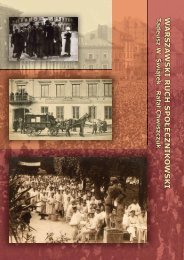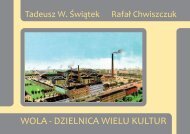You also want an ePaper? Increase the reach of your titles
YUMPU automatically turns print PDFs into web optimized ePapers that Google loves.
Żydzi<br />
Kupcy żydowscy przybyli na<br />
nasze ziemie już w wieku IX,<br />
podążając szlakami handlowymi.<br />
Początek ich osadnictwa<br />
na ziemiach polskich przypada na wiek<br />
XI, kiedy to Wyprawy Krzyżowe z roku<br />
1096 i 1147 spowodowały falę imigracji<br />
Żydów do Polski. Kolejna, największa fala<br />
imigracji, miała miejsce w latach 1348-<br />
1349, w czasach tzw. epidemii „czarnej<br />
śmierci”, czyli prześladowań ludności żydowskiej<br />
w Europie Zachodniej.<br />
W roku 1356 kronikarz Jan Długosz<br />
umieszcza w „Rocznikach, czyli<br />
kronikach sławnego Królestwa Polskiego”<br />
informację o romansie Kazimierza<br />
Wielkiego z Żydówką o imieniu Esterka<br />
(ponoć król miał z tego związku<br />
dwóch synów).<br />
Pierwsza wzmianka o warszawskich<br />
Żydach pochodzi z roku 1414. Mieszkali<br />
i pracowali na ruchliwej i gęsto zaludnionej,<br />
nieistniejącej dziś ulicy Żydowskiej,<br />
pomiędzy Wąskim Dunajem<br />
i Piekarską. Pomimo, że przebywali na<br />
terenie miejskim, zasilali skarbiec książęcy,<br />
co z czasem doprowadziło do konfl<br />
iktu z warszawskimi mieszczanami.<br />
Ulica Franciszkańska – jedna z <strong>wielu</strong> przed wojną ulic Warszawy zamieszkanych przez Żydów.<br />
Ze zbiorów R. Chwiszczuka.<br />
Franciszkańska Street one of many streets inhabited by Jews in prewar period.<br />
From R. Chwiszczuk’s collection.<br />
51<br />
Jews<br />
Jews came to what was to be<br />
Poland lands as early as the 9th<br />
Century by way of Trade routes<br />
that criss-crossed Europe. The<br />
fi rst recorded Jewish settlement in Poland<br />
dates back to the 11th Century, as<br />
a consequence of persecution and forced<br />
emigration, between 1096-1147, at<br />
the hands of the Crusaders. However<br />
the largest wave of Jewish emigration<br />
in early times took place between 1348-<br />
1349. The „Black Death”, which was<br />
prevalent at the time, in western Europe,<br />
was used as a pretext to blame<br />
the Jews, and once more they sought<br />
haven from persecution in Poland. It<br />
is not very well known that in 1356,<br />
chronicler Jan Długosz recorded in<br />
his Yearbook („Roczniki, czyli kroniki<br />
sławnego Królestwa Polskiego”) that the<br />
King of Poland, Kaziemierz „The Great”<br />
(Wielki) had a Jewish mistress, Esterka,<br />
and that they had two sons.<br />
The First mention of Jews in Warsaw<br />
was in 1414. They worked and<br />
lived on a busy and a densely populated<br />
street, which doesn’t exist nowadays,<br />
but roughly was situated between<br />
present day Wąski Dunaj and Piekarska<br />
Streets. However a confl ict occurred<br />
between Jews who paid taxes to Mazowsze<br />
Princes and Warsaw citizens<br />
who paid local taxes and thus felt they<br />
were not supporting the city.<br />
Later, restrictions were relaxed<br />
somewhat, with Jews allowed to enter<br />
Warsaw, during the sitting of Parliament<br />
(„Sejm”) or Warsaw fairs. They<br />
could also obtain a special day pass<br />
from the City Council, which allowed<br />
them to stay in the city confi nes, but<br />
only until sundown. From 1666, a special<br />
Warsaw Commission („Waad Warsza”)<br />
was formed which consisted of eight<br />
members, and a Jewish Chairman, the<br />
Jewish Ambassador to the Court of the<br />
King. Their task was to over see the<br />
Parliament („Sejm”) on Jewish matters.<br />
In 1774 Jews formed an enclave in<br />
the city suburb, known as „Little Jerusalem”<br />
(where Zawisza square is today).<br />
From where Jerozolimskie Avenue derives<br />
its name. The shops in the enclave<br />
proved too successful for the other city<br />
shops. A year later the City Marshal,<br />
Stanisław Lubomirski, confi scated Jewish<br />
goods, and demolished their homes<br />
throughout Warsaw including „Little<br />
Jerusalem”. The Jews were forced to<br />
relocate to Leszno, Pociejów (Theatre<br />
Sqaure today) and Tłomackie, at the<br />
time on the outskirts of Warsaw.<br />
In 1780 Szmul Jakubowicz Zbytkower<br />
(1727-1781 lub 82) – a wealthy and<br />
unusually infl uential „progenitor” to<br />
the Bergson family in Warsaw, as well<br />
as the Royal banker to the last king of<br />
Poland, trader, middleman, industrialist<br />
and the owner of few excellently prosperous<br />
concerns founded the fi rst Jewish<br />
Cemetery at Bródno.<br />
During the Kościuszko Uprising in<br />
1794, the Jews were lead by Berk Joselewicz<br />
(1764-1809) who commanded the<br />
light cavalry regiment. In the ensuing<br />
battles, most of the soldiers were killed,




